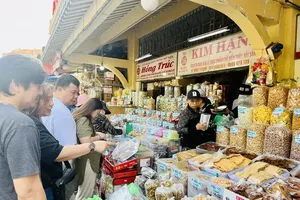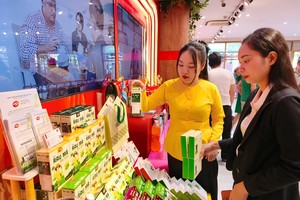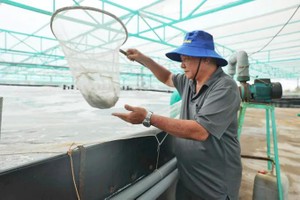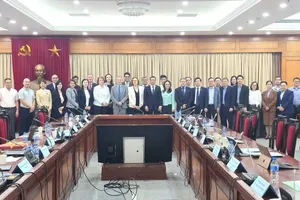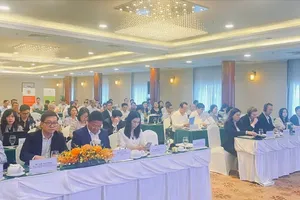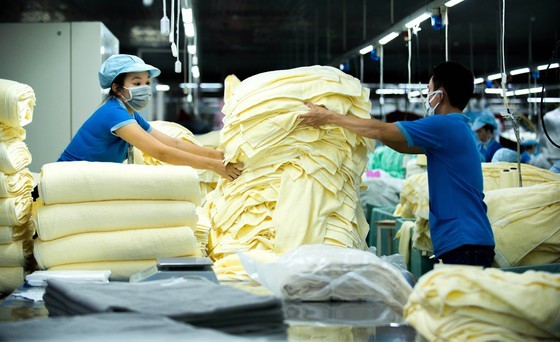
Prioritizing the production of convenience goods
Mr. Vu Duc Giang, Chairman of the Vietnam Textile and Apparel Association (Vitas), shared that the Covid-19 pandemic, which lasted from the beginning of last year to now, had significantly changed the structure of products of the garment and textile industry. For instance, the line of suits, high-end men's and women's shirts, and high-end women's dresses had been reduced by 80 percent. On the contrary, the product line of mid-range and convenient products, home wear dresses, and spandex products had highly increased, especially in the main export market of the US.
Sharing the same point of view, Mr. Le Tien Truong, Chairman of the Board of Directors of Vietnam National Textile and Garment Group (Vinatex), said that from last year to now, enterprises under the group have rapidly changed their commodity structure from high-end suits and high-end men's and women's shirts to protective clothing and knitwear. This change is also considered the main demand trend in 2021.
Not only that, the garment and textile importers of Vietnam in many markets around the world also have changes in selecting export enterprises. Accordingly, priority is given to the import of apparel products of enterprises that are committed to environmental protection, such as adopting measures to minimize waste generation, enhance recyclability, and reduce the use of fossil energy. As for fabric materials, priority is also given to environmentally friendly fabrics that do not use chemicals in the process of weaving and dyeing or dyeing without generating wastewater.
The transformation in consumer tastes and the search for partners has forced Vietnamese enterprises to quickly convert their investments to suit the new market needs.
According to Mr. Vu Duc Giang, three development strategies had been quickly deployed by domestic garment and textile enterprises. Firstly, they would review all the changes in consumer demand in the export markets. Particularly, they would focus on reviewing carefully key markets, such as the US, which accounts for 42 percent of total export turnover, and Europe.
Secondly, their production technologies would go green, reducing the use of fossil energy, cutting gas emissions, and increasing recycling waste. Enterprises would also combine this strategy with the improvement of administrative skills.
Thirdly, enterprises would urgently invest in developing products along with their brands. This is the foundation for the industry to build a more sustainable foothold in the export markets, especially in the context that several free trade agreements (FTAs) signed by Vietnam are opening up many advantages in terms of tax rates and competitiveness for garment and textile products.
Looking back to 2020, the Covid-19 pandemic had broken many raw material supply chains, as well as caused bankruptcy to many major global apparel brands. It is very important to adapt quickly to market changes. Besides, in the coming time, according to many experts, enterprises must take into account the ability to fulfill large orders with short production time because the pandemic will possibly remain complicated, and logistics activities face many difficulties.
Linking to control trade fraud
In another perspective, economic experts said that exporting enterprises should make efforts to prevent the risk of being investigated and imposed trade remedies. Information from the American Apparel and Footwear Association said that the US government is still investigating to impose new punitive tariffs on imports into the country, including garment and textile products exported from Vietnam. Moreover, in November last year, the US Department of Commerce (DOC) officially announced to initiate an anti-dumping investigation on polyester-textured yarn (PTY) exported from Vietnam.
Mr. Do Thang Hai, Deputy Minister of Industry and Trade, said that the application of trade remedies will cause much harm to domestic enterprises, not only in the US market but also in many other markets due to the domino effect. To prevent this risk, it is essential to implement dual solutions to effectively support enterprises. Accordingly, enterprises themselves need to link up to prevent the act of abetting foreign enterprises in changing the origin of their products. The Government needs to build preferential policies to attract investment without prioritizing investment attraction in industries that are the strengths of domestic enterprises. This will help to reduce competitive pressure in the export markets.
The representative of Vitas suggested that the Government soon negotiates and signs strategic cooperation with the US to increase export advantages for the garment and textile industry in particular and other industries that are also exporting to this market, in general. Moreover, many trade counselors also said that Vietnamese apparel and textile enterprises need to expand their export market share to Northern Europe and Australia.
In these markets, Vietnamese export products merely account for a modest proportion with about 2 percent of total imports from countries and territories around the world. These markets have signed FTAs with Vietnam, so the import tariffs are also extremely preferential. Therefore, increasing exports in these areas not only helps enterprises to increase market share but also reduces the risk of being imposed trade remedies.
Mr. Vu Duc Giang, Chairman of the Vietnam Textile and Apparel Association (Vitas), shared that the Covid-19 pandemic, which lasted from the beginning of last year to now, had significantly changed the structure of products of the garment and textile industry. For instance, the line of suits, high-end men's and women's shirts, and high-end women's dresses had been reduced by 80 percent. On the contrary, the product line of mid-range and convenient products, home wear dresses, and spandex products had highly increased, especially in the main export market of the US.
Sharing the same point of view, Mr. Le Tien Truong, Chairman of the Board of Directors of Vietnam National Textile and Garment Group (Vinatex), said that from last year to now, enterprises under the group have rapidly changed their commodity structure from high-end suits and high-end men's and women's shirts to protective clothing and knitwear. This change is also considered the main demand trend in 2021.
Not only that, the garment and textile importers of Vietnam in many markets around the world also have changes in selecting export enterprises. Accordingly, priority is given to the import of apparel products of enterprises that are committed to environmental protection, such as adopting measures to minimize waste generation, enhance recyclability, and reduce the use of fossil energy. As for fabric materials, priority is also given to environmentally friendly fabrics that do not use chemicals in the process of weaving and dyeing or dyeing without generating wastewater.
The transformation in consumer tastes and the search for partners has forced Vietnamese enterprises to quickly convert their investments to suit the new market needs.
According to Mr. Vu Duc Giang, three development strategies had been quickly deployed by domestic garment and textile enterprises. Firstly, they would review all the changes in consumer demand in the export markets. Particularly, they would focus on reviewing carefully key markets, such as the US, which accounts for 42 percent of total export turnover, and Europe.
Secondly, their production technologies would go green, reducing the use of fossil energy, cutting gas emissions, and increasing recycling waste. Enterprises would also combine this strategy with the improvement of administrative skills.
Thirdly, enterprises would urgently invest in developing products along with their brands. This is the foundation for the industry to build a more sustainable foothold in the export markets, especially in the context that several free trade agreements (FTAs) signed by Vietnam are opening up many advantages in terms of tax rates and competitiveness for garment and textile products.
Looking back to 2020, the Covid-19 pandemic had broken many raw material supply chains, as well as caused bankruptcy to many major global apparel brands. It is very important to adapt quickly to market changes. Besides, in the coming time, according to many experts, enterprises must take into account the ability to fulfill large orders with short production time because the pandemic will possibly remain complicated, and logistics activities face many difficulties.
Linking to control trade fraud
In another perspective, economic experts said that exporting enterprises should make efforts to prevent the risk of being investigated and imposed trade remedies. Information from the American Apparel and Footwear Association said that the US government is still investigating to impose new punitive tariffs on imports into the country, including garment and textile products exported from Vietnam. Moreover, in November last year, the US Department of Commerce (DOC) officially announced to initiate an anti-dumping investigation on polyester-textured yarn (PTY) exported from Vietnam.
Mr. Do Thang Hai, Deputy Minister of Industry and Trade, said that the application of trade remedies will cause much harm to domestic enterprises, not only in the US market but also in many other markets due to the domino effect. To prevent this risk, it is essential to implement dual solutions to effectively support enterprises. Accordingly, enterprises themselves need to link up to prevent the act of abetting foreign enterprises in changing the origin of their products. The Government needs to build preferential policies to attract investment without prioritizing investment attraction in industries that are the strengths of domestic enterprises. This will help to reduce competitive pressure in the export markets.
The representative of Vitas suggested that the Government soon negotiates and signs strategic cooperation with the US to increase export advantages for the garment and textile industry in particular and other industries that are also exporting to this market, in general. Moreover, many trade counselors also said that Vietnamese apparel and textile enterprises need to expand their export market share to Northern Europe and Australia.
In these markets, Vietnamese export products merely account for a modest proportion with about 2 percent of total imports from countries and territories around the world. These markets have signed FTAs with Vietnam, so the import tariffs are also extremely preferential. Therefore, increasing exports in these areas not only helps enterprises to increase market share but also reduces the risk of being imposed trade remedies.
